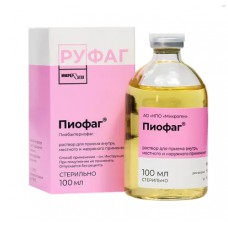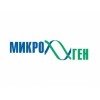Expiration date: 01/2027
Dosage form
Transparent yellow liquid of varying intensity, a greenish tint is possible.
Composition
1 ml of the drug contains:
Active substance:
Sterile purified filtrates of phagolysates of bacteria Staphylococcus, Enterococcus, Streptococcus, Escherichia coli, Proteus vulgaris, Proteus mirabilis (with Appelman activity - at least 10-5), Pseudomonas aeruginosa, Klebsiella pneumoniae, Klebsiella oxytoca (with Appelman activity - at least 10-4) - up to 1 ml.
Auxiliary substances:
preservative - 8-hydroxyquinoline sulfate - 0.0001 g/ml (calculated content);
or 8-hydroxyquinoline sulfate monohydrate in terms of 8-hydroxyquinoline sulfate - 0.0001 g/ml (calculated content).
Pharmacotherapeutic Group
Pharmacodynamics
The drug causes specific lysis of bacteria Staphylococcus, Enterococcus, Streptococcus, Escherichia coli, Proteus vulgaris, Proteus mirabilis, Pseudomonas aeruginosa, Klebsiella pneumoniae, Klebsiella oxytoca.
Indications
Treatment and prevention of purulent-inflammatory and intestinal diseases caused by staphylococci, enterococci, streptococci, Pseudomonas aeruginosa, Klebsiella, pathogenic E. coli of various serogroups, proteus with internal, rectal and external use:
- diseases of the ear, throat, nose, respiratory tract and lungs - inflammation of the sinuses, middle ear, sore throat, pharyngitis, laryngitis, tracheitis, bronchitis, pneumonia, pleurisy;
- surgical infections - suppuration of wounds, burns, abscess, phlegmon, boils, carbuncles, hydroadenitis, panaritia, paraproctitis, mastitis, bursitis, osteomyelitis;
- urogenital infections - urethritis, cystitis, pyelonephritis, colpitis, endometritis, salpingoophoritis;
- posttraumatic conjunctivitis, keratoconjunctivitis, purulent corneal ulcers and iridocyclitis;
- enteral infections - gastroenterocolitis, cholecystitis, dysbiosis;
- generalized septic diseases;
- purulent-inflammatory diseases of newborns - omphalitis, pyoderma, conjunctivitis, gastroenterocolitis, sepsis, etc.;
- other diseases caused by bacteria of staphylococci, streptococci, enterococci, proteus, klebsiella pneumonia and oxytocin, Pseudomonas aeruginosa and E. coli.
For preventive purposes, the drug is used for the treatment of surgical and freshly infected wounds, as well as for the prevention of nosocomial infections according to epidemic indications.
Contraindications
Hypersensitivity to the components of the drug.
Method of administration and dosage
Treatment of purulent-inflammatory diseases with localized lesions should be carried out simultaneously both locally and through the mouth, 7-20 days (according to clinical indications).
Depending on the nature of the focus of infection , the bacteriophage is used:
1. Topically in the form of irrigation, lotions and tamponing with liquid phage in an amount of up to 200 ml, depending on the size of the affected area. In abscesses, the bacteriophage is injected into the cavity of the focus after removal of pus by puncture. The amount of the injected drug should be slightly less than the volume of the removed pus. In osteomyelitis, after appropriate surgical treatment, a bacteriophage of 10-20 ml is poured into the wound.
2. Introduction into the cavities - pleural, articular and other limited cavities up to 100 ml of bacteriophage, after which a capillary drainage is left, through which the bacteriophage is re-injected for several days.
3. With cystitis, pyelonephritis, urethritis, the drug is taken orally. If the cavity of the bladder or renal pelvis is drained, the bacteriophage is injected through a cystostomy or nephrostomy 1-2 times a day, 20-50 ml into the bladder and 5-7 ml into the renal pelvis.
4. In case of purulent-inflammatory gynecological diseases, the drug is injected into the cavity of the vagina, uterus in a dose of 5-10 ml daily once.
5. With purulent-inflammatory diseases of the ear, throat, nose, the drug is administered in a dose of 2-10 ml 1-3 times a day. Bacteriophage is used for rinsing, washing, instillation, introduction of moistened turundum (leaving them for 1 hour).
6. With conjunctivitis and keratoconjunctivitis, the drug is instilled according to
2-3 drops 4-5 times a day, with purulent corneal ulcer - 4-5 drops, with purulent iridocyclitis, the drug is used 6-8 drops every 3 hours in combination with taking
inside.
7. In the treatment of stomatitis and chronic generalized periodontitis, the drug is used in the form of mouthwashes 3-4 times a day at a dose of 10-20 ml, as well as by introducing turundum impregnated with piobacteriophage into periodontal pockets for 5-10 minutes.
8. In intestinal forms of the disease, diseases of internal organs, dysbiosis, the bacteriophage is used through the mouth and in an enema. Through the mouth, the bacteriophage is given 3 times a day on an empty stomach 1 hour before meals. In the form of enemas, they are prescribed 1 time a day instead of one intake through the mouth.
Recommended dosages of the drug
Age Dose per 1 dose (in ml)
through the mouth in an enema
Up to 6 months 5 10
From 6 months to 1 year 10 20
From 1 year to 3 years 15 30
From 3 to 8 years 20 40
From 8 years and older 30 50
The use of bacteriophages does not exclude the use of other antibacterial drugs. If chemical antiseptics were used to treat wounds before the bacteriophage was used, the wound should be thoroughly washed with a sterile 0.9% sodium chloride solution.
The use of bacteriophage in children (up to 6 months). In sepsis, enterocolitis of newborns, including premature infants, the bacteriophage is used in the form of high enemas (through a gas outlet tube or catheter) 2-3 times a day (see Table). In the absence of vomiting and regurgitation, it is possible to use the drug through the mouth. In this case, it is mixed with breast milk. A combination of rectal (in enemas) and oral (through the mouth) use of the drug is possible. The course of treatment is 5-15 days. With a recurrent course of the disease, repeated courses of treatment are possible. In order to prevent sepsis and enterocolitis with intrauterine infection or the risk of nosocomial infection in newborns, the bacteriophage is used in the form of enemas 2 times a day for 5-7 days.
In the treatment of omphalitis, pyoderma, infected wounds, the drug is used twice daily in the form of applications (a gauze napkin is moistened with a bacteriophage and applied to the umbilical wound or to the affected area of the skin).
If there is no improvement after treatment, or the symptoms worsen, or new symptoms appear, it is necessary to consult a doctor. Use the drug only according to the indications, the method of application and in the doses specified in the instructions.
Side effect. Allergic reactions are possible. If you have the side effects listed in the instructions, or they worsen, or you notice any other side effects not listed in the instructions, inform your doctor.
Overdose. Cases of overdose have not been reported to date.
Drug interaction
The use of the drug is possible in combination with other medications, including antibiotics.
Special instructions
Use during pregnancy and during breastfeeding.
It is advisable to use the drug during pregnancy and during breastfeeding.
Special instructions. An important condition for effective phage therapy is the preliminary determination of the sensitivity of the pathogen to the bacteriophage and early use of the drug.
The drug is not suitable for use in vials with impaired integrity or labeling, with expired shelf life, with turbidity.
Due to the content of the nutrient medium in the preparation, in which bacteria from the environment can develop, causing turbidity of the drug, it is necessary to observe the following rules when opening the bottle:
- wash your hands thoroughly;
- treat the cap with an alcohol-containing solution;
- remove the cap without opening the stopper;
- do not place the cork with the inner surface on the table or other objects;
- do not leave the bottle open;
- keep the opened bottle only in the refrigerator.
Before use, the bottle with the bacteriophage must be shaken and viewed. The drug should be transparent.
Opening the vial and extracting the required volume of the drug can be carried out with a sterile syringe by puncturing the cork. The preparation from the opened bottle, subject to the storage conditions, the above rules and the absence of turbidity, can be used throughout the shelf life.
Influence on the ability to drive vehicles, mechanisms.
The drug does not affect the ability to perform potentially dangerous activities that require increased concentration and speed of psychomotor reactions (including driving vehicles, working with moving mechanisms).
Storage temperature
from 2? to 8?
Special storage conditions
Transportation conditions. At a temperature from 2 to 8 ° C, it is allowed to transport at a temperature from 9 to 25 ° C for no more than 1 month.
Storage conditions. At a temperature of 2 to 8 ° C in a place protected from light.


